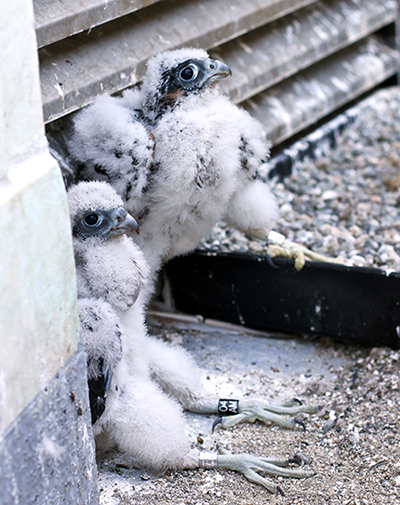Baby peregrine falcon Lux hits window on campus, dies
Fledgling peregrine falcon Lux, one of two chicks born on UC Berkeley’s Campanile in May, died yesterday after flying into a window on the 10th floor of Evans Hall on campus

July 12, 2017
Fledgling peregrine falcon Lux, one of two chicks born on UC Berkeley’s Campanile in May, died yesterday after flying into a window on the 10th floor of Evans Hall on campus.

Lux (left) and Fiat in June after they were banded (Photo by Mary Malec)
Lux, so named by the campus community in a Facebook survey, took her first flight last week and had been successfully flying and doing food transfers with her parents. But late yesterday afternoon, she flew onto a balcony on the 10th floor of Evans Hall and got trapped.
Mary Malec, a volunteer raptor nest monitor for the East Bay Regional Park District who worked with volunteers to monitor the fledglings while they learned to fly, says she was called at 8 p.m. to see if she could help the chick, who was still stuck on the balcony. When she got to Lux, however, Malec discovered the peregrine had hit a window in her attempt to escape the balcony and had died from the impact.
Malec says window strikes are a common cause of death of raptors. “Windows reflect the sky and clouds,” she says. “It looks like they are flying into the open sky.”
She says there is a move to make bird-safe windows — LeConte Hall on campus, for example, has decals on the breezeway between buildings, which helps birds avoid an accidental collision.
The two peregrine babies — the first to be born on Berkeley’s campus — and the volunteers dedicated to keeping them safe have drawn a lot of attention from local and national media and the community. Experts banded the chicks in June (Lux wore band 04).
The world’s fastest animal, peregrine falcons can reach speeds of more than 200 miles per hour, killing their prey — other birds — in mid-air. Once on the brink of extinction, they have made a remarkable comeback and have begun moving from their natural cliff faces into urban areas, laying their eggs on skyscrapers and other tall buildings, like the Campanile.
Lux’s body will go to the California Department of Fish and Wildlife to be tested for toxins in its tissue. After samples are taken, her body will be taken to Berkeley’s Museum of Vertebrate Zoology to join the more than 184,000 bird specimens used for research.
Learn more about the campus’s first peregrine family on Berkeley News.
